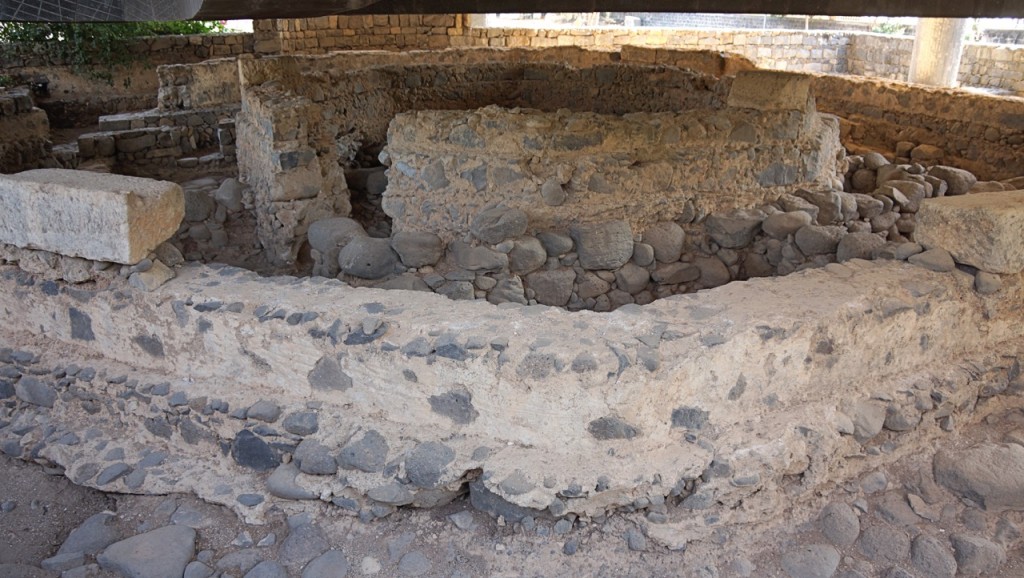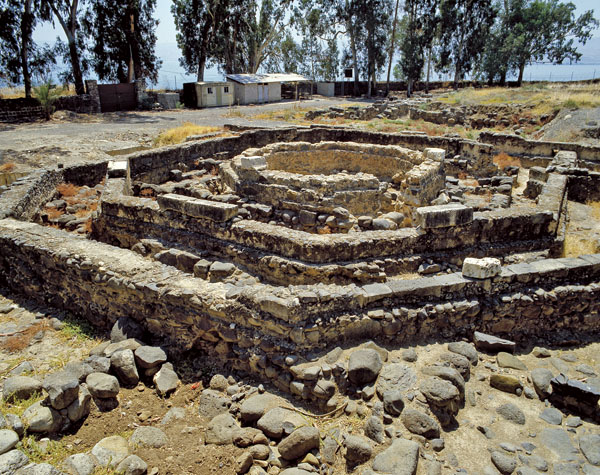
Matthew 8
14 And when Jesus entered Peter’s house, he saw his mother-in-law lying sick with a fever. 15 He touched her hand, and the fever left her, and she rose and began to serve him. 16 That evening they brought to him many who were oppressed by demons, and he cast out the spirits with a word and healed all who were sick. 17 This was to fulfill what was spoken by the prophet Isaiah: “He took our illnesses and bore our diseases.”
One of the coolest and most moving archaeological discoveries in Israel in recent times is the discovery of Simon Peter’s house in Capernaum, excavations of which began in 1968.


Roni recently pulled out her photo album from her last trip to Israel (she has been twice) and showed me what it looks like. The Zondervan Illustrated Bible Backgrounds Commentary offers some fascinating information about this site.
The majority of scholars now believe that excavations undertaken in 1968 have basically confirmed the authenticity of this claim [i.e., that this is Peter’s house].
The building was used as a typical home for an extended family from approximately 63 B.C. until A.D. 50. Peter and Andrew apparently moved the family fishing business from Bethsaida to Capernaum and established their residence in this house, large enough for an extended family. Mark tells us it was the home of both Peter and Andrew (cf. Mark 1:29).
During the second half of the first century A.D. the use of the house changed. Domestic pottery ceased to be used and the walls of the large center room were plastered—quite unusual for the region except for where groups of people gathered. Graffiti that mention Jesus as “Lord” and “Christ” in Greek were found. These pieces of evidence indicate that during this time the house became a center of Christian worship.
The house-church continued in existence for nearly three hundred years, as is evidenced from over a hundred Greek, Aramaic, Syriac, Latin, and Hebrew graffiti scratched on the plastered walls, along with numerous forms of crosses, a boat, and other letters. Among the graffiti are at least two possible occurrences of Peter’s name.
And later:
Pottery shards, oil lamps, and coins discovered in the ruins date back to the first century, along with artifacts that included several fishhooks in the earliest layers of the floor.
The commentary also quotes Princeton New Testament scholar James Charlesworth as saying, “The discovery is virtually unbelievable and sensational. Despite the sensational nature of the find, learned archaeologists and historians have slowly come to the same conclusion.”[1]
I love stuff like this, when major finds have so much evidence that they earn the acceptance of the oftentimes very skeptical field of archaeologists and historians. If Charlesworth finds the discovery of this house to be “virtually unbelievable and sensational,” I bet he must find what happened in this house to be off the charts! It is here, in the home of Peter and Andrew, that Jesus’ next miracle takes place.
An Example of Surprising Compassion: Jesus Heals a Woman
Matthew 8 is a chapter that demonstrates in powerful ways just how surprising the love of God truly is. It does this by showing Jesus healing and showing compassion to a number of those in society who, for various reasons, experienced a degree of ostracization. We see this first in Jesus’ healing of a leper. Then we see it in Jesus’ healing of a Roman centurion’s servant (all three of those words presented obstacles to the average Jewish person of the time). Now Jesus does something that would have offended some of the more conservative members of Jewish society.
14 And when Jesus entered Peter’s house, he saw his mother-in-law lying sick with a fever. 15 He touched her hand, and the fever left her, and she rose and began to serve him.
Jesus touches a woman. Specifically, he touches Peter’s mother-in-law. He touches her and heals her. We know that in some rabbinic writings from the time men were not allowed to touch a woman who was not their spouse. In doing this, Jesus was violating social custom once again. He was not doing this, of course, just to be provocative. There is a point: that in the Kingdom of God the ground is level and the old social taboos (or a morally neutral neutral nature) are shattered. The Kingdom is for lepers and centurions and slaves and women.
It is said that some very traditional rabbis would pray, “Lord, I thank you that I am not a goy (Gentile), a slave, or a woman.”[2] This tells us everything we need to know about how some viewed women. Against this backdrop, Jesus honors this woman by seeing her, approaching her, touching her, and healing her.
Stigmas are still attached to mothers-in-law, in some respects. I recall as a student at Southwestern Baptist Theological Seminary in the mid-90s, in Dr. Alan Brehm’s New Testament class, that a student, attempting to be humorous, raised his hand and asked, “Is it true that Peter denied Jesus because Jesus healed his mother-in-law in Matthew 8?” I will never forget that. To be fair, he was obviously attempting shock humor. I suppose it worked! But stigmas do remain indeed…and Jesus still destroys such attempts to shame people.
What a beautiful picture of the Kingdom this is! Jesus heals this dear woman. Jesus sees you no matter how insignificant society might say you are.
A Model of Discipleship: Healed to Serve
There is something else here that we dare not miss and we see it in Peter’s mother-in-law’s reaction to Jesus upon being healed.
14 And when Jesus entered Peter’s house, he saw his mother-in-law lying sick with a fever. 15 He touched her hand, and the fever left her, and she rose and began to serve him.
And she rose and began to serve him. This, too, is a beautiful picture. She is healed. She serves. This is the very model of discipleship illustrated in the behavior of this unnamed lady.
Frank Stagg asks, “Is the lesson that healing and saving are with a view to service?” He concludes, “Jesus enables one to fulfill his role in life.” Craig Keener agrees and says that this passage establishes “the model for discipleship: after Jesus transforms a person, the person serves him.”[3]
I agree. Healing, salvation, and transformation should result in service. It is all the more shocking, then, to find how even the forgiven child of God can fall easily into a desire to avoid service! An anonymous poet has rightly turned the spotlight on those who keep expecting “somebody else” to serve in their stead.
There’s a clever young fellow named Somebody Else—
There’s nothing this fellow can’t do.
He’s busy from morning ’til late at night
Just substituting for you.
When asked to do this or asked to do that
So often you’re set to reply:
“Get Somebody Else, Mr. Chairman—
He’ll do it much better than I.”
There’s so much to do in our church;
So much, and the workers are few.
And Somebody Else gets weary and worn
Just substituting for you.
So next time you’re asked to do something worthwhile
Come up with this honest reply:
If Somebody Else can give time and support,
It’s obviously true, so can I.[4]
This much is true: Peter’s mother-in-law knew nothing of Somebody Else, nor would she expect him to serve in her place. Why? Because service is a privilege and a joy.
But it is more than even that. In Matthew 20:28, Jesus said that “the Son of Man came not to be served but to serve, and to give his life as a ransom for many.” This establishes the ultimate rationale for service as well as the interpretive key for understanding Peter’s mother-in-law’s reaction: we serve not only because we are grateful to Jesus but also because we want to be like Him. This lady was healed by the servant King…how could she not serve in return?
Think of it: Jesus served her with the ministry of healing, then she served Him. We are most like Jesus when we serve and we demonstrate that we are His disciples when we serve as He serves.
The scope of Jesus’ work: now and then
The wider aftermath of the miracle can be seen in the crowd that comes to Jesus that night.
16 That evening they brought to him many who were oppressed by demons, and he cast out the spirits with a word and healed all who were sick. 17 This was to fulfill what was spoken by the prophet Isaiah: “He took our illnesses and bore our diseases.”
Why did they come at night? This is because, as we learn in Mark 1:21, this miracle happened on the Sabbath. This crowd of the possessed and sick came after the Sabbath had ended, in other words. What is truly intriguing, however, is that Matthew tells us this was done to fulfill some words from Isaiah. The words he quotes come from the familiar words of Isaiah 53. Specifically, Matthew quotes Isaiah 53:4, but the wider context is important to see:
3 He was despised and rejected by men, a man of sorrows and acquainted with grief; and as one from whom men hide their faces he was despised, and we esteemed him not. 4 Surely he has borne our griefs and carried our sorrows; yet we esteemed him stricken, smitten by God, and afflicted. 5 But he was pierced for our transgressions; he was crushed for our iniquities; upon him was the chastisement that brought us peace, and with his wounds we are healed. 6 All we like sheep have gone astray; we have turned—every one—to his own way; and the Lord has laid on him the iniquity of us all.
I said that referencing this passage was intriguing. Here is why it is: it is intriguing because these verses are known as the Suffering Servant verses and are usually seen as referring to the coming Messiah’s atonement for our sins. In other words, the “griefs” and “sorrows” of verse 4 are usually interpreted spiritually, not physically. And this is not incorrect. It is likely that Isaiah and the Jews of his time or of the first century did not see a great radical gulf between the physical and the spiritual. And, to be sure, while not every illness is a result of some specific sin (Jesus shattered that myth in John 9:1-3—”As he passed by, he saw a man blind from birth. And his disciples asked him, ‘Rabbi, who sinned, this man or his parents, that he was born blind?’ Jesus answered, ‘It was not that this man sinned, or his parents, but that the works of God might be displayed in him.’”) it is certainly true, in a wider sense, that all illness and infirmity is a result of the fall of the human race and the cosmos.
But I think what is truly important about Matthew saying that this healing fulfilled Isaiah 53:4 is that it means that the atoning saving work of Christ really will lead to a new heaven and new earth, that it is not merely spiritual (read “non-physical”) but that it encompasses the whole human being.
Craig Blomberg agrees with this but argues that we must be careful with this idea as well. He points out that some charismatic Christians argue on the basis of this passage that coming to Jesus will result both in forgiveness of one’s sins as well as physical healing (since, once again, Matthew appealed to Isaiah 53’s atonement passage in describing Peter’s mother-in-law’s healing). But this is a dangerous idea if the point is missed. Not all who are born again are healed and, most importantly, not all who were born again in Jesus’ years of incarnation were healed either. Blomberg argues that “[c]laims that so far all who were sick in Jesus’ presence seem to have been cured must be balanced with the data of John 5:1-15, in which Christ selected only one of many sick people to receive healing.” He further points out that it is not “adequate to reply that the others didn’t ask to be made well, because the man Jesus chose to heal didn’t ask either.”[5]
It seems best, then, to interpret Matthew’s appeal to Isaiah 53 as a recognition that Jesus’s redemptive work is both a “now” reality and a “then” reality. It means “then” that we will be in glory on the basis of the finished work of Christ. It means “now” that our lives are transformed as well. That transformation may take the form of physical healing, but—and this is important—it may not. It will always take the form of the believer being set free to serve. Remember: there are two acts of transformation in this passage: she moves from sick to healed and moves from immobile to serving. Jesus may grant the former, but He will always grant the latter. In this sense, the saving work of Christ is always “now” and “then.”
Will Metzger once wrote a book entitled Tell the Truth: The Whole Gospel to the Whole Person by Whole People. I think that title gets at what is happening here. The whole gospel truly is applied to the whole person, physical and spiritual, here and now. Our whole lives our changed! It is not merely that one gets to go to heaven when one meets Jesus in repentance and faith. It is also that one is now transformed and empowered to follow and serve Him and others in His name.
This is life in the Kingdom: forgiveness, healing, the old made new, and the dead made alive. And this is the result: we get to serve King Jesus even now!
[1] Michael J. Wilkins, “Matthew.” Zondervan Illustrated Bible Backgrounds Commentary. Gen. Ed., Clinton E. Arnold. Vol.1 (Grand Rapids, MI: Zondervan, 2002), p.56-57.
[2] https://www.myjewishlearning.com/article/three-blessings/
[3] Frank Stagg, “Matthew.” General Articles, Matthew-Mark. The Broadman Bible Commentary. Vol. 8 (Nashville, TN: Broadman Press, 1969), p.125. Craig S. Keener, The IVP Bible Background Commentary: New Testament. (Downers Grove, IL: InterVarsity Press, 1993), p.176.
[4] http://www.christianitytoday.com/biblestudies/questions/theology/spiritualgifts.html
[5] Craig L. Blomberg, Matthew. The New American Commentary. Gen. Ed., David S. Dockery. Vol.22 (Nashville, TN: Broadman Press, 1992), p.145.

Pingback: Matthew | Walking Together Ministries
Good word Brother !
Thanks so much Alan!